| Article ID | Journal | Published Year | Pages | File Type |
|---|---|---|---|---|
| 1975451 | Comparative Biochemistry and Physiology Part B: Biochemistry and Molecular Biology | 2012 | 9 Pages |
Cysteine proteases are present in all living organisms and, in animals, function in a vast array of physiological and pathological processes. Cysteine protease inhibitors act upon the cysteine proteases to regulate their activity. The cystatin superfamily of cysteine protease inhibitors has members represented in all living organisms studied to date. Here, we report the identification of a new member of the family 1 cystatin in Oplegnathus fasciatus rock bream (denoted as RbCyt B) and the characterization at the molecular level. The complete genomic sequence of RbCyt B consists of three exons and a promoter region. The open reading frame (ORF) encodes for a 100 amino acids length polypeptide with a single cystatin-like domain and a cysteine protease inhibitor signature motif. The conserved N-terminal glycine, glutamine-valine-glycine motif, QxVxG, and a variant of the proline-tryptophan, PW, motif were identified. RbCyt B showed closest phylogenetic distance to Dicentrarchus labrax cystatin B, and shared up to 73% amino acid identity and 90% amino acid similarity with known cystatin B genes. RbCyt B mRNA expression was detected in nine different tissues and was highly expressed in liver, spleen, gill, brain, intestine, kidney, head kidney, and blood, as compared with muscle. In vivo immune stimulation with Edwardsiella tarda bacteria caused significant up-regulation of RbCyt B mRNA in head kidney and spleen at 24 h post-infection (P < 0.05). Recombinant RbCyt B was expressed in Escherichia coli, and the purified protein demonstrated 82% papain inhibitory activity at 500 × 10− 3 μg μL− 1 in a concentration-dependent manner. These results suggest that RbCyt B is a member of family 1 cystatin with high homology to cystatin B, and is a biologically active protein possessing papain inhibitory activity and potentially involved in immune responses against invading Gram-negative bacteria in rock bream.
